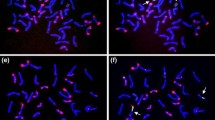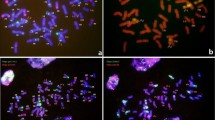Abstract
To introduce useful genes from the wild species Thinopyrum intermedium into cultivated wheat, a wheat-Th. intermedium disomic addition line (TAI27) was used as source material for tissue culture. TAI27 contains, beside the 42 wheat chromosomes, a pair of smaller chromosomes that is cytologically discernible. Based on restriction fragment length polymorphism (RFLP) analysis, this chromosome pair was determined to be a recombinant one, comprising segments with homoeology to at least two chromosome groups of wheat, i.e., group 2 and 7. Sixty-eight green plants were regenerated from six month-old embryogenic calli initiated from immature embryos of TAI27. Four of the plants were found to have only 42 cytologically normal-looking chromosomes. Southern blot analysis using a Th. intermedium-enriched repetitive probe showed that one of the plants had hybridization fragments specific to Th. intermedium, indicating introgression of chromatin during the cell culture process.
Similar content being viewed by others
References
Banks PM, Larkin PJ, Bariana HS, Lagudah ES, Appels R, Waterhouse PM, Brettell RIS, Chen X, Xu HJ, Xin ZY, Qian YT, Zhou XM, Cheng ZM & Zhou GH (1995) The use of cell culture for subchromosomal introgression of barley yellow dwarf virus resistance from Thinopyrum intermedium to wheat. Genome 38: 395-405
Feinberg AP & Vogelstein B (1983) A technique for radio-labeling DNA restriction fragments to a high specific activity. Anal. Biochem. 132: 6-13
Gale MD, Atkinson MD, Chinoy CN, Harcourt RL, Jia J, Li QY & Devos KM (1993) Genetic maps of hexaploid wheat. In: Li ZS & Xin ZY (eds). Proc. 8th Int. Wheat Genet. Symp. (pp 29-40). China Agricultural Scientech Press, Beijing
He MY, Xu ZY, Zou MQ, Zhang H, Piao ZS & Hao S (1988). The establishment of two sets of alien addition lines of wheat-wheatgrass. Sci. Sin. (Series B) 32: 695-705
Kidwell KK & Osborn TC (1992) Simple plant DNA isolation procedures. In: Beckmann JS & Osborn TC (eds). (pp 1-3) Plant Genomes: Methods for Genetic and Physical Mapping. Kluwer Academic Publishers, Dordrecht, The Netherlands
Larkin PJ, Banks PM, Lagudah ES, Appels R, Chen X, Xin ZY, Ohm HW & McIntosh R (1995) Disomic Thinopyrum intermedium addition lines in wheat with barley dwarf virus resistance and with rust resistance. Genome 38: 385-394
Lapitan NLV, Sears RG & Gill BS (1984) Translocations and other karyotypic structural changes in wheat x rye hybrids regenerated from tissue culture. Theor. Appl. Genet. 68: 547-554
Liu B, Sega LG, Vega JM, Feldman M & Abbo S (1997) Isolation and characterization of chromosome-specific DNA sequences from a chromosome arm-specific library of common wheat. The Plant Journal 11: 959-965
Wu QS, Liu B & Liu DJ (1993) Wheat protoplast culture and morphogenesis. J. Nanjing Agri. Univ. 16: 1-6
Zhang XQ, Chen DW, Bu XL, He MY & Hao S (1991) Variation of Thinopyrum intermedium chromosomes in wheat-Th. intermedium alien addition lines. Acta Genet. Sin. 18: 344-351
Author information
Authors and Affiliations
Corresponding author
Rights and permissions
About this article
Cite this article
Liu, B., Luan, Y., Han, F. et al. Cell culture induced introgression of Thinopyrum intermedium chromatin into common wheat. Plant Cell, Tissue and Organ Culture 65, 9–13 (2001). https://doi.org/10.1023/A:1010610325332
Issue Date:
DOI: https://doi.org/10.1023/A:1010610325332




